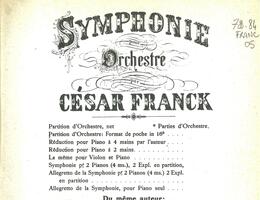Symphonie en ré mineur
1. Lento – Allegro non troppo – 2. Allegretto – 3. Allegro non troppo
Franck composed his only symphony in his twilight years, between 1886 and 1888. Dedicated to Henri Duparc, the score was poorly received at its premiere on 17 February 1889 in Paris, at the Concerts du Conservatoire, conducted by Jules Garcin. It wasn’t until 19 November 1893, at the Concerts Lamoureux, that the work established itself. Perhaps the originality of the form and the somewhat austere tone had initially puzzled listeners, although abandoning the traditional four movements was nothing new, as already illustrated by Saint-Saëns in his Symphony No. 3 “with organ” (1886) and d’Indy in his Symphonie sur un chant montagnard français (1887). But Franck chose a novel option, since the Allegretto in second position serves as both a slow movement and a scherzo. According to Pierre de Bréville, Franck commented on his score as follows: “It is a classical symphony. At the beginning of the first movement there is a reprise, as was once done to better assert the themes, but in a different key. Then come an Andante and a Scherzo, linked to each other. I wanted each beat of the Andante to equal one bar of the Scherzo, so that after the two movements had been fully developed the Scherzo could be superimposed on the first. I succeeded. The Finale, like that of [Beethoven’s] Ninth, recalls all the themes; but they don’t appear as quotations, I make something out of them, they play the role of new elements.” The D minor Symphony adopts the cyclical principle dear to Franck, forming the backbone of a dramatic spiritual journey that leads from darkness to light, from the erratic opening Lento to the final apotheosis.

